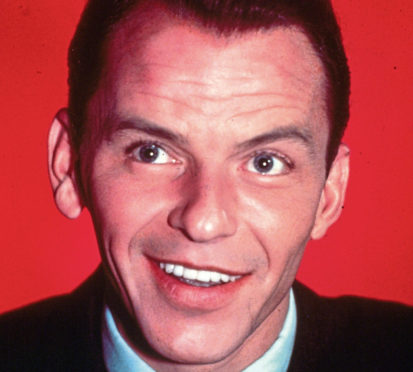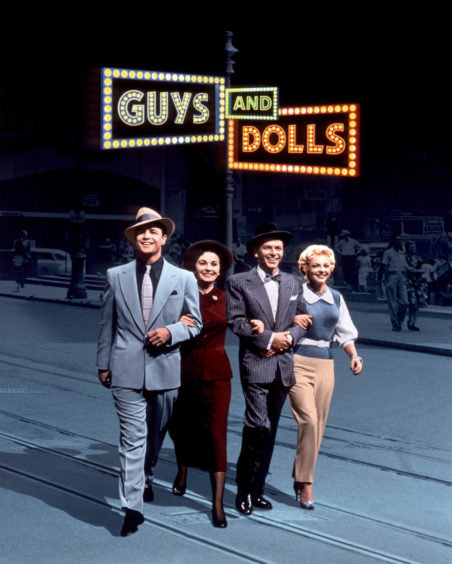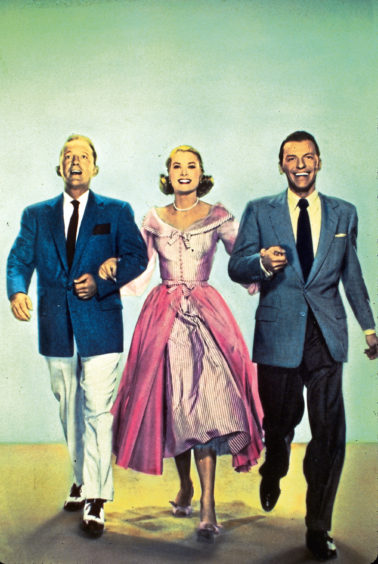
Frank Sinatra closed the year 1955 on a high, with a cracking new album in process and a blockbuster movie.
The album, Songs For Swingin’ Lovers, wouldn’t appear until March the next year but the film, Guys And Dolls, was a massive success.
This was despite Frank having wanted a different part and Marilyn Monroe being turned down when she desperately wanted to appear with him!
Sinatra had craved the role of Sky Masterson, which went to Marlon Brando, and by all accounts the relationship between them was iffy, Frank giving Brando the nickname Mumbles.
Frank played Nathan Detroit, a gambler trying to arrange an unlicensed crap game, while Brando’s character was another gambler who would bet on just about anything, any time, anywhere.
Miss Adelaide, the part Marilyn was after, was Nathan’s nightclub singer fiancé. Vivian Blaine, who had played her so well in the theatre production got it, though it would’ve been nice to see Ol’ Blue Eyes and the Blonde Bombshell together.
With Jean Simmons as Sister Sarah Brown, Sky’s girl, the movie ended with both couples getting married in Times Square.
It was a massive hit and even Marilyn couldn’t be too downhearted, having enjoyed great success that year with The Seven Year Itch.
Songs For Swingin’ Lovers, Sinatra’s 10th album and his fourth on the Capitol label, saw Frank at the age of 40 singing at his best.
With Nelson Riddle doing the arranging, it saw Frank jazzing up pop songs, and with tracks like I’ve Got You Under My Skin, You Make Me Feel So Young and the fantastic Anything Goes, it became an instant Sinatra classic.
It is still rated by many as his greatest album, and these years really were a dream for the man with the golden voice.
Close To You, his first 1957 collection, isn’t quite as well-known today as Swingin’ Lovers, but it was almost as good.
With Riddle at the helm again, and reporting that Sinatra himself loved it, the album featured a string quartet and an intriguing mix of songs by many different composers and lyricists, including Truman Capote, the novelist best-known for In Cold Blood and Breakfast At Tiffany’s.
Frank put out no fewer than four albums that year, including a Christmas one, but had huge success with the follow-up to Close To You, A Swingin’ Affair!.
It kicked off with Cole Porter classic Night And Day but the original release omitted, believe it or not, The Lady Is A Tramp.
They had good reason, though, as it was also on the soundtrack to one of Frank’s 1957 movies, Pal Joey.
It cast him alongside Rita Hayworth and Kim Novak – all this fame and fortune, and he got to work with such women every day, too. It wasn’t difficult, being Frank Sinatra.
As Sinatra, never a man to miss a beautiful woman, joked, “That’s a sandwich I don’t mind being stuck in the middle of.”
Indeed!
The film was set in San Francisco, Sinatra playing Joey Evans, a mediocre singer known for chasing women at every opportunity.
Novak was Linda English, a naïve chorus girl, and Hayworth played Vera Prentice-Simpson, a lonely but rich widow who used to be a stripper.
The normally lecherous Joey falls in love with Linda, but he is also seeing Vera, who gets jealous and demands the girl is fired.
In his favourite kind of “sandwich”, Sinatra thrived, one critic noting, “This is largely Mr Sinatra’s show. He projects a distinctly bouncy, likeable personality into an unusual role.”
It didn’t even faze him that Hayworth, not as big a name as him at that time, got top billing. “Ladies first!” was his carefree response to questions about the matter.
He had developed a good relationship with Novak in the 1955 flick The Man With The Golden Arm, in which he played an addict and drug dealer who also happens to be handy on the drums.
Just imagine how shocking that was back then, and the sight of Sinatra injecting himself was a powerful image.
Novak was Molly, his old flame who encourages him to focus on his drumming, even locking him in her apartment to go cold turkey and get off the drugs.
Well ahead of its time, it came as no surprise that Sinatra was nominated for an Academy Award for Best Actor in a Leading Role.
The man could sing, as we know, but he really was a fine actor, too, when put with the right colleagues and the right kind of script.
A much lighter movie, High Society would prove a great hit, too – Grace Kelly was superb in her last film before she became royalty, and Bing Crosby, Louis Armstrong and Sinatra conjured up great fun.
Cole Porter provided the music as only he could. Just as one example, specifically for this movie he came up with a certain Who Wants To Be A Millionaire.
They don’t make movies, or songwriters, like these any more.
Less than a week into 1958, Sinatra hit yet another high spot with his latest album, Come Fly With Me, his first collaboration with arranger and conductor Billy May.
A drawing of him on the front cover at an airport hinted at the theme inside, with songs portraying a trip around the world.
Sinatra may have hated the artwork, saying it looked like an airline advertisement, but George Martin, future Beatles legend, dropped in on the recording sessions and was impressed.
It was nominated for the Grammy for Album of the Year and sold like hot cakes.
The only people who didn’t seem to love the whole album were the family of Rudyard Kipling.
The one they didn’t fancy was On The Road To Mandalay, based on the Kipling poem, and it was later replaced by It Happened In Monterey.
Another very good year, was 1958 – his next LP was Frank Sinatra Sings For Only The Lonely, another cracker that still gets five-star reviews to this day.
A collection of sad torch songs, similar to the downbeat style of Wee Small Hours, it always stands out for its cover, with Sinatra done up like a sad clown.
The cover was courtesy of Nicholas Volpe, the Connecticut artist famed for painting famous faces in unusual ways.
This got a Best Album Cover Grammy for Volpe, who would later do all four Beatles as single portraits during their first tour of the USA.
It’s interesting to study several Sinatra album covers, and see how they continue to influence much more recent stars. Not everybody understood the importance of the whole package, but Frank did.
Tracks like One For My Baby (And One More For The Road) and Angel Eyes would feature in Sinatra’s concert setlists for years to come, such was the strength of his latest album.
Not content with ruling the roost in the music charts, Frank was also showing he could still do a special movie when he fancied.
Even filmmaker-extraordinaire Martin Scorsese has highlighted Some Came Running, Sinatra’s 1958 film, as one of the most influential, and it was great. The story of a troubled Army vet who comes home after years away, to the annoyance of his rich, social climber brother, Sinatra turned in a great performance.
He also got the best out of his co-star, Shirley MacLaine, by getting them to change the ending – Shirley said it was because of this alteration that she got her first Oscar nomination.
Filmed in Indiana, they say that Sinatra could barely get a minute’s peace for the crowds of ladies keen to set eyes on him.
Only Frank Sinatra, and maybe a Mr Presley in years to come, had this kind of power…
His 1959 album covers demonstrate what was becoming a bit of a formula.
He was on the front, winking and beckoning you to join him on the front of Come Dance With Me!. But for No One Cares, he was the lonesome guy at the bar, leaning on his chin, ciggie and bourbon in hand, ruminating on lost love, presumably.
A happy, light one, followed by a dark, heartbroken one – both collections did incredibly well yet again, Sinatra calling the second album a set of “suicide songs”.
His singing on the first one, however, was described as “vocals that dance”. He had become a master of turning on the happiness of sadness as required, and was able to do it better than anyone else on the planet.
As you’ll see in next week’s concluding part of our Frank Sinatra series, he would just keep getting bigger and better, regardless of the new, young acts approaching with rock ’n’ roll and all that.

Enjoy the convenience of having The Sunday Post delivered as a digital ePaper straight to your smartphone, tablet or computer.
Subscribe for only £5.49 a month and enjoy all the benefits of the printed paper as a digital replica.
Subscribe © Mgm/Samuel Goldwyn/Kobal/Shutterstock
© Mgm/Samuel Goldwyn/Kobal/Shutterstock  © Snap/Shutterstock
© Snap/Shutterstock